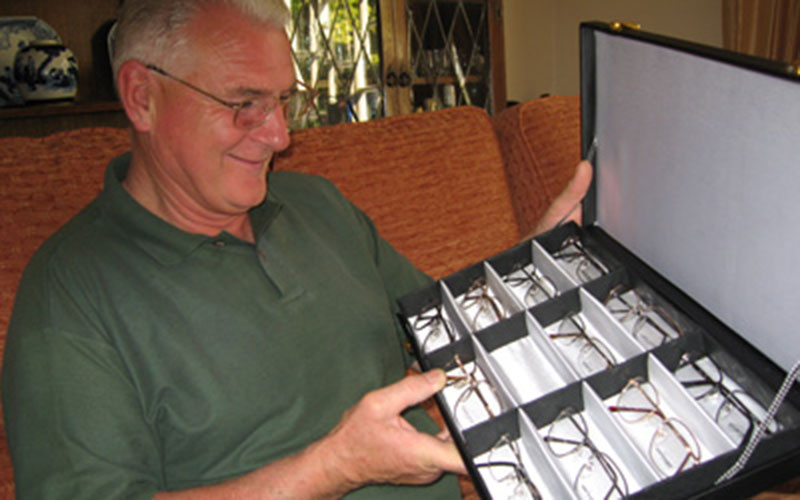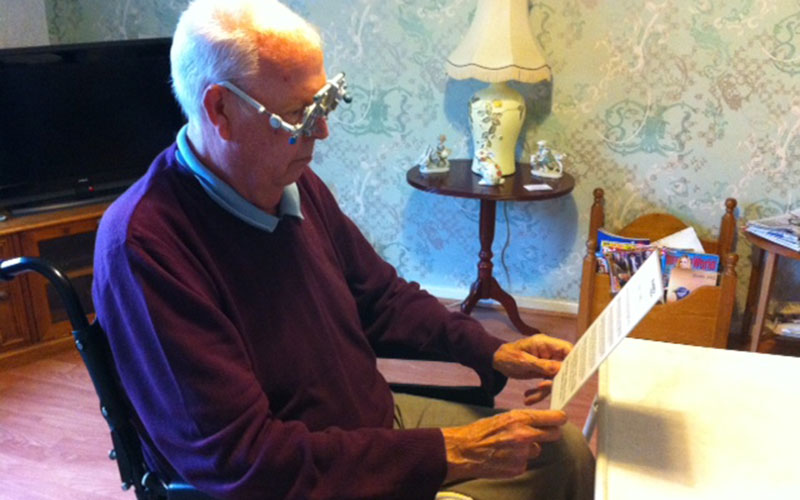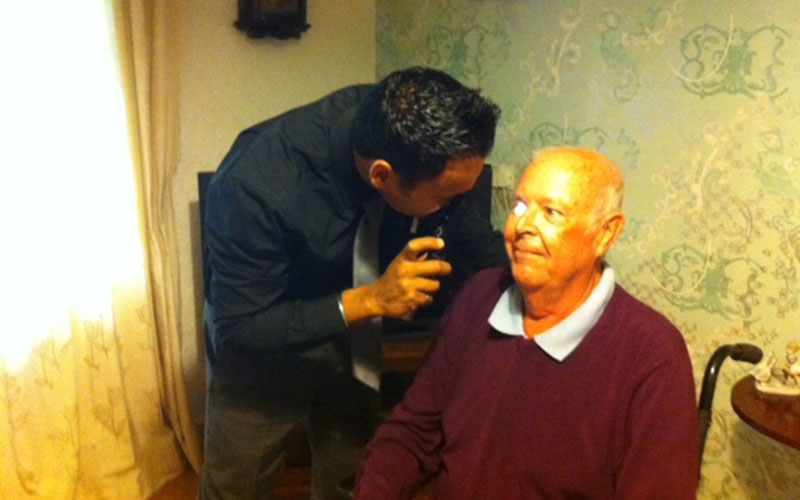Here is some information on some common eye conditions which effect the elderly population.
This information has been provided by the Eye Care Trust. You can also visit their website at www.eyecaretrust.org.uk and click on the "eye information" tab to find out about a host of other conditions.
The Eyecare Trust is a registered charity that exists to raise awareness of all aspects of eye health and the importance of regular eyecare and is partly funded through donations.
Macular degeneration
Macular degeneration
What is the macula?
Imagine that your eye is like a camera. There is a lens and an aperture (an opening) at the front, which both adjust to bring objects into focus on the retina at the back of your eye. The retina is made up of a delicate tissue that is sensitive to light, rather like the film in a camera. The macula is found at the centre of the retina where the incoming rays of light are focused. The macula is very important and is responsible for:
- What we see straight in front of us
- The vision needed for detailed activities such as reading and writing
- Our ability to appreciate colour.
What is macular degeneration?
Sometimes the delicate cells of the macula become damaged and stop working. We do not know why this is, although it tends to happen as people get older. This is called age-related macular degeneration. Because macular degeneration is an age-related process it usually involves both eyes, although they may not be affected at the same time. With many people the visual cells simply cease to function, like the colours fading in an old photograph - this is known as 'dry' degeneration. Sometimes there is scarring of the macula caused by leaking blood vessels and this is called disciform maculopathy. Children and young people can also suffer from an inherited form of macular degeneration called macular dystrophy. Sometimes several members of a family will suffer from this, and if this is the case in your family it is very important that you have your eyes checked regularly.
And now the good news
Macular degeneration is not painful, and never leads to total blindness. It is the most common cause of poor sight in people over 60 but never leads to complete sight loss because it is only the central vision that is affected. Macular degeneration never affects vision at the outer edges of the eye. This means that almost everyone with macular degeneration will have enough side vision to get around and keep their independence.
What are the symptoms?
In the early stages your central vision may be blurred or distorted, with things looking an unusual size or shape. This may happen quickly or develop over several months. You may be very sensitive to light or actually see lights that are not there. This may cause some discomfort occasionally, but otherwise macular degeneration is not painful. The macula enables you to see fine detail and people with the advanced condition will often notice a blank patch or dark spot in the centre of their sight. This makes activities like reading, writing and recognising small objects or faces very difficult.
What should I do if I think I have macular degeneration?
If you suspect that you may have macular degeneration but there are no acute symptoms you should see your doctor or optometrist (optician) who will refer you to an eye specialist. If you have acute symptoms then you should consult your doctor or local casualty department immediately. If macular degeneration has already been diagnosed in one of your eyes, and your other eye is getting acute symptoms, then you should go to the hospital that usually looks after you, or your local casualty department, as soon as possible.
What does an examination involve?
Firstly there will be an assessment of your vision in both eyes. Then you will be given eye drops which enlarge your pupil so that your eye specialist can look into your eye. The drops take about 20 minutes to work although their effect may last for several hours. Your vision will become blurred for a while and your eyes will become very sensitive to light, but this is nothing to worry about.
What is fluorescein angiography?
In some cases your eye specialist may decide that a fluorescein angiogram will also be needed. This involves taking a series of colour photographs of your retina with bright flashes of light. These photographs give an accurate map of the changes occurring in the macula and help your eye specialist to decide what is the best treatment for you. For the angiogram you will be given a small injection of special dye in your arm which then works its way around to your eye. This is not painful but you may feel a bit sick. A series of rapid pictures are then taken with a blue light over the next few minutes. There are few side effects, although some people find that they are dazzled for a while afterwards. You may also notice that the injection has left your skin with a faint yellow tinge from the fluorescein dye but this soon passes as it is excreted in your urine.
Can I be helped to see better?
Don't be discouraged - you can be helped to see better. With disciform degeneration laser treatment can help some people if the condition is diagnosed early enough. There are also a variety of optical aids which make use of the parts of the retina that are not affected. These range from brighter reading lights and simple magnifying glasses to more sophisticated equipment. Ask your doctor to refer you to the hospital low vision clinic.
What does laser treatment involve?
If you have disciform degeneration certain abnormalities on the macula can sometimes be treated by laser. This is usually done as an outpatient, and although it may cause some discomfort, is not painful. You will sit at a slit lamp and special contact lens are put into the eye to help focus the laser onto the macula. Unfortunately, with most people the areas of degeneration are in the middle of the macula, at its focal point. This means that treatment cannot be given because the scars produced by the laser would make central vision worse rather than better. Laser treatment is useful for about 10 per cent of people with disciform degeneration, and this always where people have reported their symptoms early. If successful it can prevent things getting worse, and sometimes bring back sight that is already lost. 'Dry' degeneration cannot be treated by laser.
What research is going on?
There is a great deal of research that is looking into the causes of macular degeneration and how it can be treated. With 'dry' degeneration there have been claims that certain types of medical therapy can halt the condition, but this remains uncertain. You can find out more from the:
Macular Disease Society
PO Box 247
Haywards Heath
West Sussex
RH17 5FF
Telephone 0990-143 573
For further information about RNIB services please contact us at:
Royal National Institute for the Blind
105 Judd Street
London
WC1H 9NE
Telephone 0345-766 9999
Information provided by the Royal College of Ophthalmologists and the Royal National Institute for the Blind.
Glaucoma
Glaucoma
What is glaucoma?
Glaucoma is the name for a group of eye conditions in which the optic nerve is damaged at the point where it leaves the eye. This nerve carries information from the light sensitive layer in your eye, the retina, to the brain where it is perceived as a picture. Your eye needs a certain amount of pressure to keep the eyeball in shape so that it can work properly. In some people, the damage is caused by raised eye pressure. Others may have an eye pressure within normal limits but damage occurs because there is a weakness in the optic nerve. In most cases both factors are involved but to a varying extent. Eye pressure is largely independent of blood pressure.
What controls pressure in the eye?
A layer of cells behind the iris (the coloured part of the eye) produces a watery fluid, called aqueous. The fluid passes through a hole in the centre of the iris (called the pupil) to leave the eye through tiny drainage channels. These are in the angle between the front of the eye (the cornea) and the iris and return the fluid to the blood stream. Normally the fluid produced is balanced by the fluid draining out, but if it cannot escape, or too much is produced, then your eye pressure will rise. (The aqueous fluid has nothing to do with tears.)
Why can increased eye pressure be serious?
If the optic nerve comes under too much pressure then it can be injured. How much damage there is will depend on how much pressure there is and how long it has lasted, and whether there is a poor blood supply or other weakness of the optic nerve. A really high pressure will damage the optic nerve immediately. A lower level of pressure can cause damage more slowly, and then you would gradually lose your sight if it is not treated.
Are there different types of glaucoma?
Yes. There are four main types.
The most common is chronic glaucoma (chronic = slow) in which the aqueous fluid can get to the drainage channels (open angle) but they slowly become blocked over many years (see Figure 1). The eye pressure rises very slowly and there is no pain to show there is a problem, but the field of vision gradually becomes impaired.
Acute glaucoma (acute = sudden) is much less common in western countries. This happens when there is a sudden and more complete blockage to the flow of aqueous fluid to the eye. This is because a narrow `angle' closes to prevent fluid ever getting to the drainage channels (see Figure 2). This can be quite painful and will cause permanent damage to your sight if not treated promptly.
There are two other main types of glaucoma. When a rise in eye pressure is caused by another eye condition this is called secondary glaucoma. There is also a rare but sometimes serious condition in babies called developmental glaucoma which is caused by a malformation in the eye. This leaflet is about chronic and acute glaucoma.
How common is glaucoma?
In the UK some form of glaucoma affects about 2 in 100 people over the age of 40.
Are some people particularly at risk of chronic glaucoma?
Yes. There are several factors which increase the risk:
Age - Chronic glaucoma becomes much more common with increasing age. It is uncommon below the age of 40 but affects one per cent of people over this age and five per cent over 65.
Race - If you are of African origin you are more at risk of chronic glaucoma and it may come on somewhat earlier and be more severe. So make sure that you have regular tests.
Family - If you have a close relative who has chronic glaucoma then you should have eye tests at intervals. You should advise other members of your family to do the same. This is especially important if you are aged over 40 when tests should be done every two years.
Short Sight - People with a high degree of short sight are more prone to chronic glaucoma. Diabetes is believed to increase the risk of developing this condition.
Why can chronic glaucoma be a serious risk to sight?
The danger with chronic glaucoma is that your eye may seem perfectly normal. There is no pain and your eyesight will seem to be unchanged, but your vision is being damaged. Some people do seek advice because they notice that their sight is less good in one eye than the other.
The early loss in the field of vision is usually in the shape of an arc a little above and/or below the centre when looking `straight ahead'. This blank area, if the glaucoma is untreated, spreads both outwards and inwards. The centre of the field is last affected so that eventually it becomes like looking through a long tube, so-called `tunnel vision'. In time even this sight would be lost.
How is chronic glaucoma detected?
As glaucoma becomes much more common over the age of forty you should have eye tests at least every two years and ask for all three glaucoma tests. This has been shown to be much more effective in detecting glaucoma than just having one or two.
These tests are:
- viewing your optic nerve by shining a light from a special electric torch into your eye
- measuring the pressure in the eye using a special instrument
- you are shown a sequence of spots of light on a screen and asked to say which ones you can see.
All these tests are very straightforward, don't hurt and can be done by most high street optometrists (opticians).
How is chronic glaucoma treated?
The main treatment for chronic glaucoma aims to reduce the pressure in your eye. Some treatments also aim to improve the blood supply of the optic nerve. You will need to go to hospital for treatment and have regular check-ups afterwards. Treatment to lower the pressure is usually started with eyedrops. These act by reducing the amount of fluid produced in the eye or by opening up the drainage channels so that excess liquid can drain away. If this does not help, your specialist may suggest either laser treatment or an operation called a trabeculectomy to improve the drainage of fluids from your eye. Your specialist will discuss with you which is the best method in your particular case.
Can chronic glaucoma be cured?
Although damage already done cannot be repaired, with early diagnosis and careful regular observation and treatment, damage can usually be kept to a minimum, and good vision can be enjoyed indefinitely.
What is acute glaucoma?
In acute glaucoma the pressure in the eye rises rapidly. This is because the periphery of the iris and the front of the eye (cornea) come into contact so that aqueous is not able to reach the tiny drainage channels in the angle between them. This is sometimes called closed angle glaucoma.
What are the symptoms of acute glaucoma?
The sudden increase in eye pressure can be very painful. The affected eye becomes red, the sight deteriorates and may even black out. There may also be nausea and vomiting. In the early stages you may see misty rainbow coloured rings around white lights.
Is acute glaucoma always severe?
Sometimes people have a series of mild attacks, often in the evening. Vision may seem `misty' with coloured rings seen around white lights and there may be some discomfort in the eye. If you think that you are having mild attacks you should contact your doctor without delay. In routine examinations the structure of the eye may make the examiner suspect a risk of acute glaucoma and advise further tests.
What is the treatment?
If you have an acute attack you will need to go into hospital immediately so that the pain and the pressure in the eye can be relieved. Drugs will be given which both reduce the production of aqueous liquid in the eye and improve its drainage.
An acute attack, if treated early, can usually be brought under control in a few hours. Your eye will become more comfortable and sight starts to return. When the pain and inflammation have gone down, your surgeon will advise making a small hole in the outer border of the iris to relieve the obstruction, allowing the fluid to drain away. This is usually done by laser treatment or by a small operation.
Usually the surgeon will also advise you to have the same treatment on the other eye, because there is a high risk that it will develop the same problem. The treatment is not painful. Depending on circumstances and the response to treatment, it may not require admission to hospital. Sometimes a short stay in hospital may be advised.
Can acute glaucoma be cured?
If diagnosed without delay and treated promptly and effectively there may be almost complete and permanent recovery of vision. Delay may cause loss of sight in the affected eye. Occasionally the eye pressure may remain a little raised and treatment is required as for chronic glaucoma.
Will I be able to drive?
Most people can still drive if the loss of visual field is not advanced. To assess possible damage to your peripheral vision you will need a special test to see whether your sight meets the standards of the Driver and Vehicle Licensing Authority. Ask your specialist about this. The IGA leaflet about driving may also be helpful.
What if my sight cannot be fully restored?
Early detection and treatment will usually prevent or retard further damage by glaucoma. Much can be done to help you use your remaining vision as fully as possible. You should ask your optician or optometrist about low vision aids and whether you are eligible to register as partially sighted or blind. Registration opens the door to expert help and sometimes to financial benefits.
Further help and information
The International Glaucoma Association supports patients by providing information, so that they can co operate fully in their treatment and prevent sight loss. It also promotes awareness and early detection of glaucoma, and supports and carries out research. Available for advice by letter or by telephone 10am - 5pm from Monday to Friday.
The International Glaucoma Association (IGA)
Woodcote House, 15 Highpoint Business Village
Henwood
Ashford
Kent TN24 8DH
Telephone 01233 64 81 70
The Partially Sighted Society offers information and advice, publications, aids to vision, enlargement services and local support to help you make the most of your vision. Contact:
The Partially Sighted Society
Queen's Road
Doncaster
DN1 2NX
Telephone 01302-323132
Information provided by: Royal College of Ophthalmologists & International Glaucoma Association
Diabetic retinopathy
Diabetic retinopathy
What is diabetes?
Diabetes mellitus or `sugar diabetes' affects about one person in fifty in the UK. This means that the body cannot cope normally with sugar and other carbohydrates in the diet.
Diabetes can start in childhood, but it often begins later in life. It can cause complications, which affect different parts of the body. There are two types of diabetes mellitus - one is controlled by insulin injections and the other by diet or tablets, but they both affect the eyes in the same way.
If you have diabetes this does not necessarily mean that your sight will be affected, but there is a higher risk. If your diabetes is well controlled then you are less likely to have problems, or they may be less serious. However if there are complications which affect the eyes then this can result in loss of sight.
Why are regular eye tests are important?
Most sight loss from diabetic retinopathy can be prevented. But it is vital that it is diagnosed early. You may not realise that there is anything wrong with your eyesight, and so regular eye checks are extremely important.
How can diabetes affect the eye?
Your eye has a lens and an aperture (opening) at the front, which adjust to bring objects into focus on the retina at the back of the eye. The retina is made up of a delicate tissue that is sensitive to light, rather like the film in a camera.
At the centre of the retina is the macula, which is a small area about the size of a pinhead. This is the most highly specialised part of the retina and it is vital because it enables you to see fine detail and read small print. The other parts of the retina give you side vision (peripheral vision). Filling the cavity of the eye in front of the retina is a clear jelly-like substance called the vitreous humour.
Diabetes can affect the eye in a number of ways. These usually involve the fine network of blood vessels in the retina - hence the term diabetic retinopathy.
Temporary blurring
Your vision may become blurred for a few days or weeks while your diabetes is first being controlled. This is due to the swelling of the lens of the eye and will soon clear without treatment soon after the diabetes is controlled.
Cataract
This can occur in two forms:
• young people with diabetes very occasionally develop a special type of cataract. Although their vision gets worse, it can be restored by surgery;
• Older people with diabetes can be especially prone to developing cataracts. Cataracts can be successfully removed by surgery and usually it is possible to insert a lens implant. However this is unsuitable for some people and you will be told if this is the case.
Diabetic retinopathy
The most serious diabetic eye condition involves the retina and is called diabetic retinopathy.
Background diabetic retinopathy
This condition is very common in people who have had diabetes for a long time. Your doctor may be able to see abnormalities in your eyes, but there is no threat to your sight. There are two types of diabetic retinopathy, which can damage your sight. Both involve the fine network of blood vessels in the retina. They are described below.
Maculopathy
This happens when the blood vessels in the retina start to leak.
- If the macula is affected, you will find that your central vision gradually gets worse. You may find it difficult to recognise people's faces in the distance or to see detail such as small print. The amount of central vision that is lost varies from person to person. However the vision which allows you to get around at home and outside (navigation vision) will be preserved.
- It is very rare for someone with maculopathy to lose all his or her sight.
Proliferative diabetic retinopathy
Sometimes diabetes can cause the blood vessels in the retina to become blocked. If this happens then new blood vessels form in the eye. This is nature's way of trying to repair the damage so that the retina has a new blood supply.
Unfortunately these new blood vessels are weak. They are also in the wrong place - growing on the surface of the retina and into the vitreous jelly. Consequently these blood vessels can bleed very easily and cause scar tissue to form in the eye. The scarring pulls and distorts the retina. When the retina is pulled out of position this is called retinal detachment.
- This condition is rarer than background retinopathy and is more often found in people who have been insulin dependent for many years.
- The new blood vessels will rarely affect your vision, but their consequences, such as bleeding or retinal detachment can cause your vision to get worse suddenly.
- Your eyesight may become blurred and patchy as the bleeding obscures part of your vision.
- Without treatment, total loss of vision can happen in proliferative retinopathy. With treatment most sight-threatening diabetic problems can be prevented if caught early enough.
The importance of early treatment
Although your vision may be good, changes can be taking place to your retina that need treatment. And because most sight loss in diabetes is preventable:
- early diagnosis is vital
- have an eye examination every year
- do not wait until your vision has deteriorated to have an eye test.
Your family doctor, diabetologist or optometrist can examine for diabetic retinopathy. Photographs are sometimes used to detect abnormalities without any other form of test. If a problem is found you will be referred to a consultant ophthalmologist (a doctor specialising in eyes) at a hospital eye clinic.
Remember, however, that if your vision is getting worse, this does not necessarily mean you have diabetic retinopathy. It may simply be a problem that can be corrected by glasses.
What is the treatment?
Most sight-threatening diabetic problems can be prevented by laser treatment if it is given early enough. It is important to realise however that laser treatment aims to save the sight you have - not to make it better. The laser, a beam of high intensity light, can be focused with extreme precision. So the blood vessels that are leaking fluid into the retina can be sealed. If new blood vessels are growing, more extensive laser treatment has to be carried out. In eight out of ten cases laser treatment causes the new blood vessels to disappear.
How is laser treatment carried out?
All treatment is carried out in an outpatient clinic and you will not have to stay in hospital. Eye drops are used to enlarge the pupils so that the doctor can look into your eye. The eye is then numbed with drops and a small contact lens is put onto your eye to stop it blinking. The eyes need to be moved in certain directions but this can easily be done with the contact lens in place.
Is it painful?
The treatment for sealing blood vessels doesn't usually cause any discomfort. However the treatment to remove new blood vessels can be a bit uncomfortable so you may be given a pain-relieving tablet at the same time as the eyedrops. If the treatment does become painful, then it is possible to have an injection around the eye to numb the pain. Don't be afraid to ask for this injection, especially if you have found a previous session of laser treatment distressing.
Does laser treatment have any side effects?
The treatment for sealing blood vessels has few side effects, although you may lose a little central vision or notice the laser burns as small blank spots.
The laser treatment to remove new blood vessels is more complicated and there may be more side effects. It is quite common to lose some vision to the sides (peripheral vision), and this may mean that you will not be able to drive in future. Night and colour vision may also be reduced. Occasionally your central vision may not be as good as before so that print isn't as easy to see. This is usually temporary but sometimes this doesn't improve. No treatment is possible without some side effects. But the risks of laser treatment are far less than the risks of not having treatment.
What if my eye becomes painful after treatment or if my vision gets worse?
The laser is very bright and causes a temporary reduction of sight, which may last an hour or two after the treatment. Most people have a headache after the more lengthy treatment and you can take a headache tablet for this. However if the pain is severe, or if your eyesight gets worse, you should contact your consultant straightaway.
If your eye condition becomes more severe, causing retinal detachment and scar tissue, it may be possible to perform vitreous surgery. This is highly specialised and you should discuss the various options with a consultant ophthalmologist. Research is continuing into diabetes-related eye conditions, and their treatment is constantly improving.
What if my sight cannot be fully restored?
Much can be done to help you use your remaining vision as fully as possible. You should ask your eye specialist or optometrist about low vision aids. It is also worth registering as partially sighted or blind through your eye specialist. This opens the door to expert help and financial benefits.
Further Help and Information
RNIB Eye Health Campaign
The British Diabetic Association offers advice on all your medical and welfare questions. It can put you in touch with self-help groups, and campaigns on behalf of all people with diabetes. For more information please contact:
British Diabetic Association
10 Queen Anne Street
London
W1M OBD
Telephone: 200-7323 1531
The Partially Sighted Society offers information and advice, publications, aids to vision, enlargement services and local support to help you make the most of your vision. Contact:
The Partially Sighted Society
Queen's Road
Doncaster
DN1 2NX
Telephone: 01302-323132
Information provided by: Royal National Institute for the Blind & Royal College of Ophthalmologists
Cataract
Cataract
What is a cataract?
If you have been told that you have a cataract, don't be alarmed. Over half of those over 65 have some cataract development and most cases can be treated successfully with surgery. Despite what you may have heard, a cataract is not a skin that grows over your eye. A cataract is a clouding of part of your eye called the lens. Your vision becomes blurred or dim because light cannot pass through the clouded lens to the back of the eye.
The Lens
The lens is a transparent body behind the iris, the coloured part of the eye. The lens bends light rays so that they give a clear image to the back of the eye - the retina. As the lens is elastic, it will change shape, getting fatter for close objects and thinner for distant objects.
What causes a cataract?
Cataracts can form at any age, but most often develop as people get older. In younger people they can result from an injury, certain drugs, long-standing inflammation or illnesses such as diabetes.
Some symptoms
- 'I'm not seeing as well as I used to' - You may notice that some things seem blurred round the edges, or that your glasses seem dirty or scratched.
- Seeing double - The cloudiness in the lens may occur in more than one place, so that the light rays which reach the retina are split, causing a double image.
- Poor vision in bright light - You may find that bright light or very sunny days make it more difficult to see.
- Change of colour vision - As the cataract develops its centre becomes more and more yellow, giving everything you see a yellowish tinge.
What can be done to help?
The most effective treatment for cataracts is a small operation to remove the cloudy lens. This cannot be performed by laser, although laser treatment is sometimes needed afterwards. Diets or drugs have not been shown to slow or stop the development of the cataract.
What is a lens implant?
When the cloudy lens has been surgically removed it is usually replaced by a plastic lens so that the eye can focus properly. Occasionally a doctor will decide that someone's eye is not suitable for a lens implant. In these cases contact lenses or special glasses will be prescribed instead.
When should I have the operation?
Usually, you can decide if, and at what stage to have the operation. Obviously you need to bear in mind that there may be a waiting list for this. In the past, eye specialists often waited until the cataract became `ripe' before suggesting you had it removed. Nowadays, with modern surgery the operation can be carried out at any stage of the cataract's development. If visual impairment interferes with your ability to read, to work, or to do the things you enjoy then you will probably want to consider surgery. For most people, it is possible to have your operation and go home on the same day, as long as you have someone to look after you at home. Sometimes surgery will mean a short stay in hospital.
What happens in the operation?
Just before the operation you will be given eye drops to enlarge your pupil and something to help you relax if you want this. Normally cataract surgery is performed with a local anaesthetic and some sedation. The local anaesthetic numbs the area that is being operated on. You will be wide awake but feel nothing in your eye. Usually the eye specialist will explain what is happening as the operation goes along, and a nurse will be there to hold your hand and make sure you are all right. Sometimes your doctor may decide to give you a general anaesthetic. This means that you are completely unconscious, and it will be like sleeping through the operation. The operation is performed with the aid of a microscope through a small cut in the top of the eye. This is closed using small stitches at the end of the operation. The operation generally takes up to 45 minutes. A pad or shield will probably be put over your eye to protect it from accidental rubbing and bumping after the operation. We want to reassure you that your eye is not taken out of its socket during surgery. The operation is not painful and the stitches cannot be seen.
After the operation
Your sight will usually improve within a few days, although complete healing may take several months. It is a good idea to have some help at home if you can, especially if you find it difficult to put your eye drops in. You will need to take it easy for a couple of weeks so that your eye can heal:
- Avoid rubbing your eye; wear an eyeshield if you are a restless sleeper.
- Don't do any heavy lifting, and avoid strenuous exercise and swimming.
- You can do light housework or cooking, but try to get some help if you can.
- You don't need to stay indoors but take care if it is windy, in case anything blows in your eye.
- Wash your hair leaning backwards rather than forwards.
- Avoid eye make-up for six weeks.
- You can resume your sex life a week or two after the operation.
- Avoid driving until your surgeon tells you it is safe.
- New glasses are usually prescribed four to eight weeks after the operation.
- How long you are off work will depend on the job you do. Ask your eye specialist about this.


















